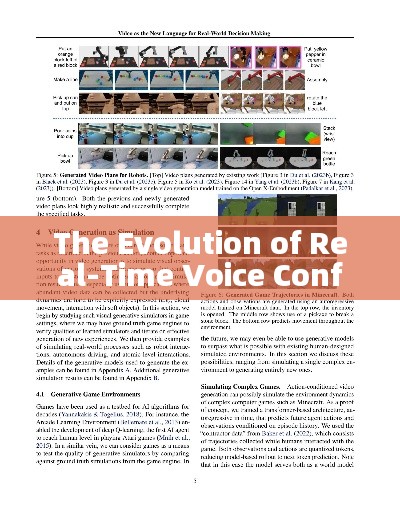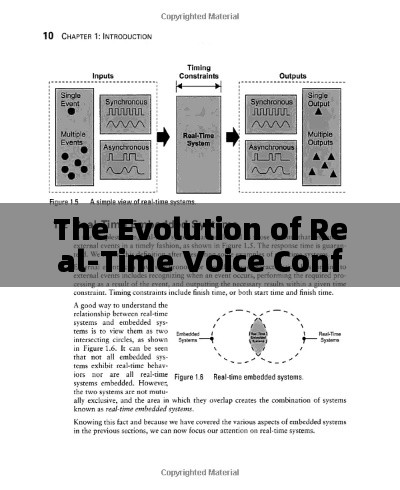The Evolution of Real-Time Voice Conference Translation
In the fast-paced world of global business and communication, the need for real-time voice conference translation has become increasingly essential. As companies expand their operations across borders and cultures, the ability to communicate seamlessly without language barriers is a game-changer. This article delves into the evolution of real-time voice conference translation, exploring its benefits, challenges, and the cutting-edge technologies that are shaping the future of cross-cultural communication.
Early Challenges and the Birth of Real-Time Translation
Before the advent of real-time voice conference translation, international meetings often relied on interpreters or written translations. These methods were time-consuming, costly, and often resulted in miscommunication. The birth of real-time translation technology marked a significant shift in how global communication was conducted.
One of the earliest notable examples of real-time translation was the IBM Language Translator, which was introduced in the 1960s. While this system was far from perfect, it laid the groundwork for future advancements. Over the years, the technology has evolved significantly, thanks to advancements in artificial intelligence, machine learning, and natural language processing.
Technologies Behind Real-Time Voice Conference Translation
The core of real-time voice conference translation lies in a combination of sophisticated technologies. Here are some of the key components:
- Speech Recognition: This technology converts spoken words into digital data, allowing the system to process and understand the language being spoken.
- Machine Translation: Using algorithms and databases, machine translation systems can translate words and phrases from one language to another. Over time, these systems have become more accurate, thanks to improvements in natural language processing.
- Post-Processing: To enhance the quality of the translation, post-processing involves refining the translated text to ensure it is grammatically correct and culturally appropriate.
Modern real-time translation systems also incorporate adaptive learning, which allows the technology to improve over time by learning from user interactions and feedback.
Benefits of Real-Time Voice Conference Translation
The benefits of real-time voice conference translation are numerous:
- Increased Productivity: By removing language barriers, teams can collaborate more effectively, leading to increased productivity and efficiency.
- Cost-Effectiveness: Hiring interpreters for every international meeting can be expensive. Real-time translation systems offer a more cost-effective alternative.
- Improved Accessibility: Real-time translation makes meetings more accessible to people with language disabilities or those who are not fluent in the primary language of the meeting.
- Enhanced Decision-Making: With clear and accurate communication, decision-making processes can be more informed and effective.
Challenges and Limitations
Despite the advancements in technology, real-time voice conference translation still faces several challenges:
- Language Complexity: Some languages are more complex than others, making accurate translation more difficult.
- Accents and Dialects: The system may struggle with understanding accents and dialects, leading to miscommunication.
- Cultural Nuances: Translating cultural nuances and idioms can be challenging, as they often don't have direct equivalents in other languages.
The Future of Real-Time Voice Conference Translation
The future of real-time voice conference translation looks promising. As technology continues to advance, we can expect the following developments:
- Improved Accuracy: With ongoing research and development, translation systems will become more accurate, reducing the likelihood of miscommunication.
- Greater Language Support: As more companies and organizations adopt real-time translation, the number of supported languages will continue to grow.
- Integration with Other Tools: Real-time translation systems will likely integrate with other communication tools, such as video conferencing platforms, to provide a seamless user experience.
In conclusion, real-time voice conference translation has come a long way since its inception. As technology continues to evolve, it will play an increasingly important role in facilitating global communication and collaboration. By overcoming the current challenges and embracing the future of this technology, we can look forward to a world where language barriers are a thing of the past.
The Evolution of Real-Time Translation at English Conferences
The Future of Communication: Real-Time Voice Conference Translation
The Evolution and Challenges of Real-Time English Translation Evaluation
The Evolution of Popular English Phrases in Everyday Life
The Impact of Social Media on Mental Health: A Comprehensive Debate
Revolutionizing Productivity: The Power of RTCS in Modern Workplaces
The Fruit of Hard Work: Unveiling the Rewards of Perseverance
The Evolution of English Pop Charts: A Deep Dive into the Most Popular Playlists














 浙ICP备2021033100号-1
浙ICP备2021033100号-1